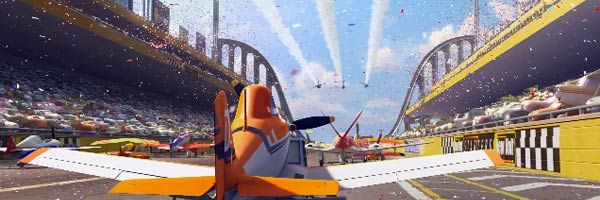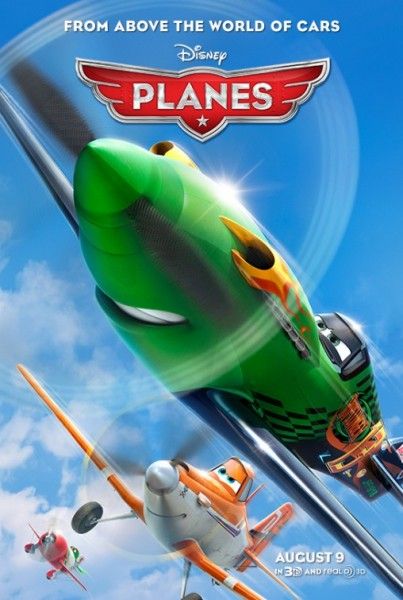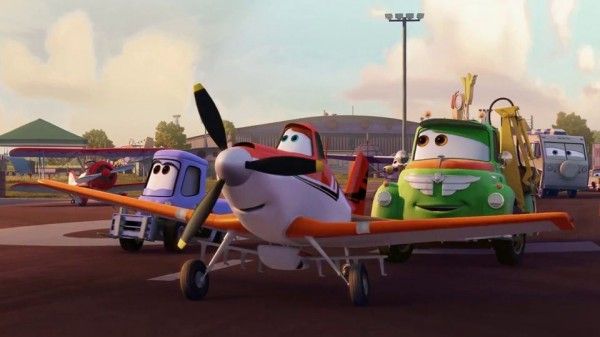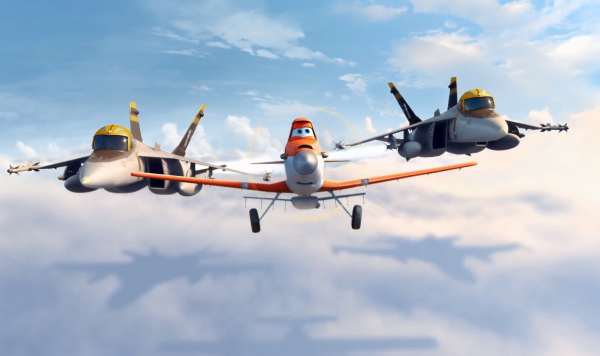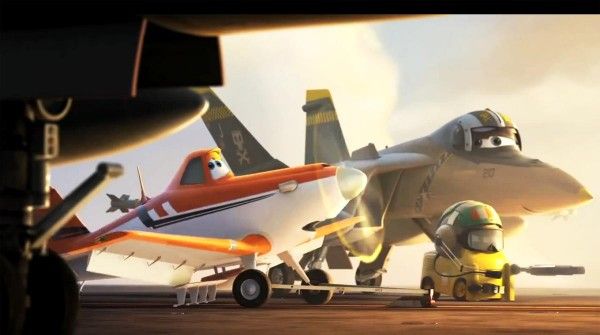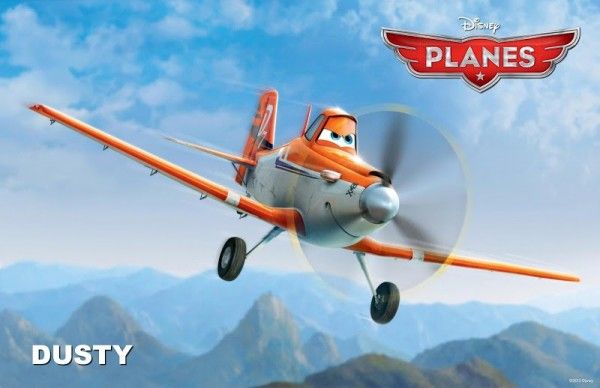Directed by aviation enthusiast Klay Hall from a screenplay by Jeffrey M. Howard and produced by Traci Balthazor-Flynn, Disney’s Planes is an action-packed 3D comedy featuring Dusty (Dane Cook), a crop duster with dreams of being the fastest air racer in the world. Set in the skies, above the world of Cars, the film was born largely from executive producer John Lasseter’s active imagination. Opening August 9th, Planes features a great group of new characters voiced by Stacy Keach, Brad Garrett, Teri Hatcher, Julia Louis-Dreyfus, Priyanka Chopra, John Cleese, Cedric the Entertainer, Carlos Alazraqui, Roger Craig Smith, Anthony Edwards, Val Kilmer, Sinbad and Gabriel Iglesias.
A few days ago I landed an exclusive interview with Hall and Balthazor-Flynn who talked about what sparked the idea for a feature film that explores the world of planes and creates a whole new set of fun and exciting characters, the involvement of the Brain Trust in every Disney animated movie, the strategy of tearing down the story again and again to get it right, their thoughts on the online theory that every Pixar film takes place in the same universe, the decision to go theatrical rather than straight to DVD/Blu-ray, and the status of the upcoming sequel, Planes: Fire & Rescue. Read the full interview after the jump.
Question: What inspired this idea for a feature film that explores the world of planes?
Klay Hall: I can tell you how it all started. For me, personally, you’re aware of my aviation background with my father, and his father taught him to fly. But early on, in the process over at DTS (Disneytoon Studios), I worked very closely with John Lasseter on my last project (Tinker Bell and the Lost Treasure). We started to share a common bond and conversations about all different machines: Formula One, F1 race cars, and trucks and vehicles and trains and planes, so we were both big fans of all things machines. He found out about my background in aviation. He found out that my dad was in the Navy, and his dad was in the Navy, so we had a few common things going on throughout our conversations. And then, as time went on and I finished my previous film, I was working on this idea about the Transcontinental Railroad with steam trains. It had animals and people in it. It had nothing to do with the Cars world. One day he had the epiphany. He called me up, and he was like, “Hey, what do you think? I know you’re working on the train thing, but what do you think about maybe shifting from the train and maybe working on Planes?” And like John, if there’s one thing I like more than trains, it’s planes. And so, we had a good laugh, and he was like, “Okay. Then let’s go. And we’re going to make it from above the world of Cars. So Cars is established. We have this Cars thing.” He goes, “So you can learn from that. You can draft from that, but let’s sort of forget about it. This is a whole new world with new characters. Let’s go explore. Let’s go have fun.” That’s kind of how it all came about.
Pixar is known for tearing down the story again and again to get it right. How many times did it happen on this one?
Hall: Wow! Good question, and you are absolutely correct.
Traci Balthazor-Flynn: Yes. We have the same filmmaking process, and so we put it up and tear it down and put it up and tear it down all the way through up until the very end.
Hall: Eight.
Balthazor-Flynn: We did eight major screenings.
Hall: We did eight major screenings and probably another eight in between that, so probably at least 16 versions on film. And then, several times when you’re in a sequence, like take for instance the training sequence with Dusty working with Skipper and him trying to teach him how to fly faster around the silos and stuff. That was probably at least 20 different passes just on that sequence to get that to work correctly.
Balthazor-Flynn: John Lasseter has this great saying, “A film is never done. It’s just released.” That’s really true. We work on the story as far as we possibly can.
Hall: That’s absolutely true. They pull it out from your hands when the time has run out.
There is an online theory that every Pixar movie takes place in the same universe. Have you heard about this theory and what are your thoughts? Is it something that people talk about at work?
Balthazor-Flynn: I’ve actually read this theory.
Hall: Wow! Have you?
Balthazor-Flynn: I saw it on the Huffington Post.
Hall: Enlightening.
Balthazor-Flynn: They basically tie all the stories of all the movies together to put it in the same universe. It’s a String Theory. I think it’s an interesting theory, but I can’t speak for the people at Pixar.
Hall: It might be more urban legend. I’m not sure.
Balthazor-Flynn: But I thought somebody clearly put a lot of thought and time into evolving that.
Hall: I mean, they clearly have a process of how they go about making their movies, and John Lasseter has been instrumental in implementing that process for all three studios with the Brain Trust and the way we work and the way we break stories and how it’s all creative led. There are no executives in the room. So I think all of that is embraced unilaterally. But that’s the first time I’ve heard of that.
Balthazor-Flynn: You’ll have to look it up.
Hall: What do you think? What’s your take on it?
I think there’s something to that.
Hall: Interesting.
From what I understand, Planes was originally going to go straight to DVD/Blu-ray and then it was decided it would be going theatrical. When did you first hear about it?
Hall: When it was going to go theatrical? It was probably about a year ago maybe or so.
Balthazor-Flynn: Yeah. Almost a year ago, not quite.
Hall: The great thing about what we do at DTS, all the studios, but especially DTS, because we’re talking about our film, is we swing for the fences. So that being said, we’re out to tell the very best story we can with the highest quality that we’re able to do. When that word came down that the company had decided that we were going to go theatrical, we hooped and hollered and wahooed and all of that stuff, but the good thing is we didn’t have to change anything. It’s not like all of a sudden we had to reset, like “Oh my gosh, we’re going to theater. We’ve got to make this better. We’ve got to make this bigger. We’ve got to add…” It was all done. So actually what that was able to do was twofold. For me, it helps illustrate what DTS is capable of doing right from the beginning. And secondly, technically, it actually gave us a little bit more time so we could just finesse some effects and things like that, because when you release theatrical, you actually get a bigger window than if you’re DVD when you have to have it done sooner so they can press the DVDs and all that kind of stuff. So it was a win-win all the way around. It was an amazing moment, not only for myself and the team behind the film, but for DTS and for John Lasseter. He was always a big fan. He was a proponent, a supporter of the whole thing, and it just worked out.
I understand Disney is already in development on a sequel. Can you talk about Planes: Fire & Rescue? Are you involved?
Hall: I am. The way I am involved is with John’s [Brain Trust]. When John came over, when Disney bought Pixar, John came in and he added several new, fresh approaches to filmmaking, and one of them was to implement the Brain Trust. Now that had worked very successfully at Pixar, and he ended up adding one at Walt Disney Animation and one at DTS. So, I’m part of that Brain Trust where I sit in on all things creative for the whole studio, but especially in the Planes area. I’m involved with every single thing that they do as far as just being aware, and then they ask my opinion. I’m involved in the sequence reviews and some of the animation reviews and character designs and things like that. I give my input on that movie as well.
Balthazor-Flynn: But there is a separate filmmaking team.
Hall: Yes. There is a whole separate filmmaking team that’s doing it, but that’s part of what’s great about the Brain Trust and about the inspiring leadership of John Lasseter. He leaves it up to that creative group of individuals to help each other elevate each thing that they’re working on to only try to make it better and to share what you’ve learned on the first one. Back in the day, it would be more competitive and hide. You do your thing. I’ll do mine. It’s not like that at all. Everyone is there to help everyone, and that gives you a great sense of not only just support, but respect and everything else that goes with it.

